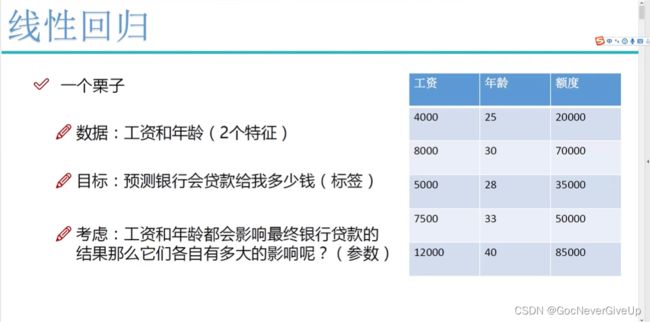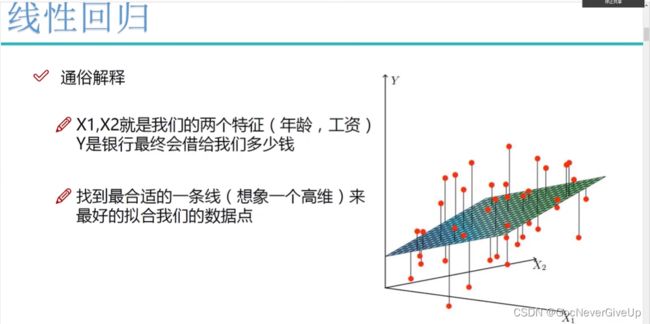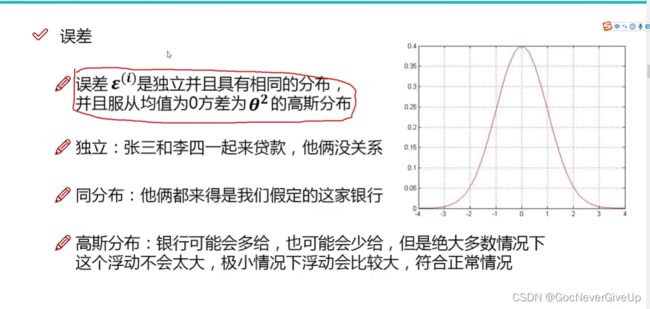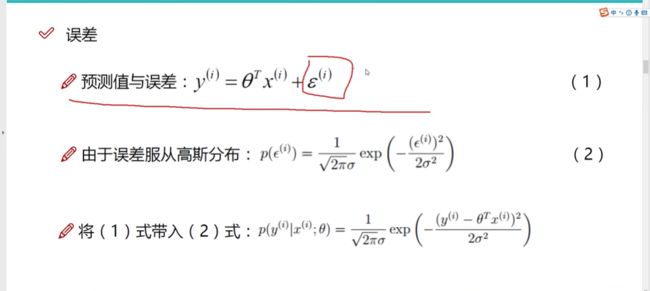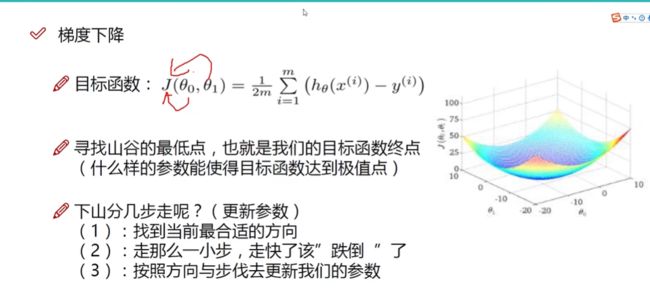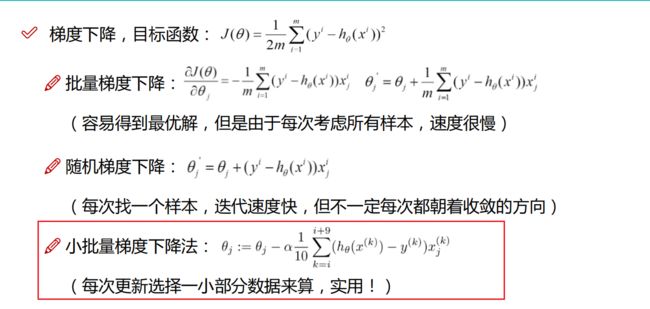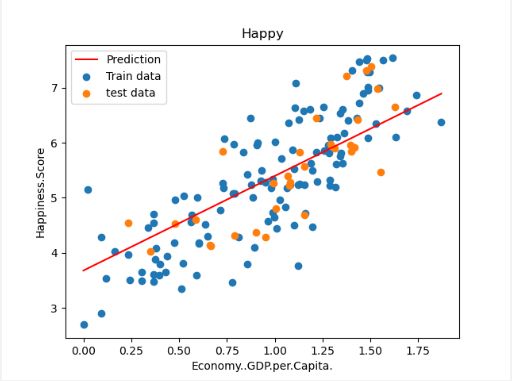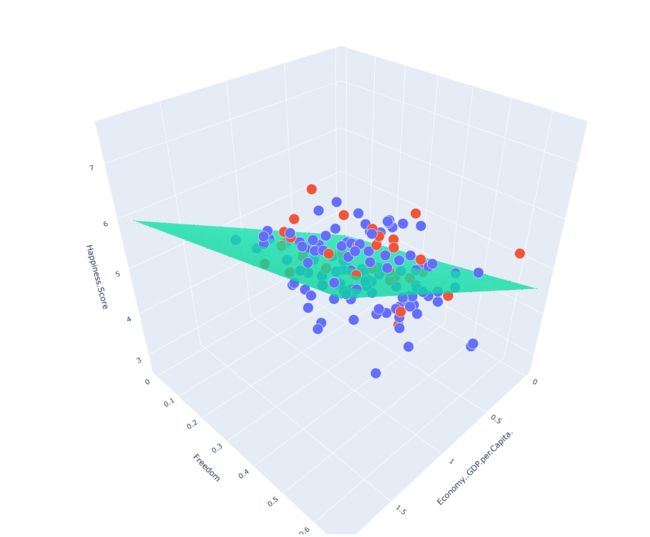机器学习1
核心梯度下降算法:
import numpy as np
from utils.features import prepare_for_training
class LinearRegression:
def __init__(self,data,labels,polynomial_degree = 0,sinusoid_degree = 0,normalize_data=True):
"""
1.对数据进行预处理操作
2.先得到所有的特征个数
3.初始化参数矩阵
"""
(data_processed, #预处理完之后的数据(标准化之后的数据)
features_mean, #预处理完之后的平均值和标准差
features_deviation) = prepare_for_training(data, polynomial_degree, sinusoid_degree,normalize_data=True)
# 在数据预处理中,对数据进行标准化(normalize)时,通常会使用数据的均值和标准差。标准化是一种常见的数据预处理技术,
# 它通过减去均值并除以标准差,将数据转换为具有零均值和单位方差的形式。这样做可以使得不同尺度的特征具有相似的重要性,有助于提高模型的性能和收敛速度。
self.data = data_processed
self.labels = labels
self.features_mean = features_mean
self.features_deviation = features_deviation
self.polynomial_degree = polynomial_degree
self.sinusoid_degree = sinusoid_degree
self.normalize_data = normalize_data
#所有特征个数
num_features = self.data.shape[1]
#最终求解的 theta 值,初始化theta参数矩阵
self.theta = np.zeros((num_features,1))
#alpha为学习率,也就是步长,越小越好;num_iterations为迭代次数
def train(self,alpha,num_iterations = 500):
"""
训练模块,执行梯度下降
"""
#cost_history记录损失变化
cost_history = self.gradient_descent(alpha,num_iterations)
return self.theta,cost_history
#梯度下降
def gradient_descent(self,alpha,num_iterations):
"""
实际迭代模块,会迭代num_iterations次
"""
#cost_history记录损失变化
cost_history = []
for _ in range(num_iterations):
self.gradient_step(alpha)
cost_history.append(self.cost_function(self.data,self.labels))
return cost_history
#实际参数更新的时候 计算步骤,公式在这里进行计算,梯度下降的核心计算过程
def gradient_step(self,alpha):
"""
梯度下降参数更新计算方法,注意是矩阵运算
"""
#样本个数
num_examples = self.data.shape[0]
#预测值
prediction = LinearRegression.hypothesis(self.data, self.theta)
#误差值delta = 预测值-真实值
delta = prediction - self.labels
#通过步长来,对theta参数进行迭代更新
theta = self.theta
#使用矩阵可以避免for循环
theta = theta - alpha*(1/num_examples)*(np.dot(delta.T,self.data)).T
self.theta = theta
#损失函数计算方法
def cost_function(self,data,labels):
"""
损失计算方法
"""
num_examples = data.shape[0]
delta = LinearRegression.hypothesis(self.data,self.theta) - labels
cost = (1/2)*np.dot(delta.T,delta)/num_examples
return cost[0][0]
#预测值 = theta * 数据, 返回矩阵点乘数据 y = theta1*x1 + theta2*x2 + ……
@staticmethod
def hypothesis(data,theta):
predictions = np.dot(data,theta)
return predictions
#获取损失值
def get_cost(self,data,labels):
data_processed = prepare_for_training(data,
self.polynomial_degree,
self.sinusoid_degree,
self.normalize_data
)[0]
return self.cost_function(data_processed,labels)
#获取预测值
def predict(self,data):
"""
用训练的参数模型,与预测得到回归值结果
"""
data_processed = prepare_for_training(data,
self.polynomial_degree,
self.sinusoid_degree,
self.normalize_data
)[0]
predictions = LinearRegression.hypothesis(data_processed,self.theta)
return predictions
"""Prepares the dataset for training"""
import numpy as np
from .normalize import normalize
from .generate_sinusoids import generate_sinusoids
from .generate_polynomials import generate_polynomials
def prepare_for_training(data, polynomial_degree=0, sinusoid_degree=0, normalize_data=True):
# 计算样本总数
num_examples = data.shape[0]
data_processed = np.copy(data)
# 预处理
features_mean = 0
features_deviation = 0
data_normalized = data_processed
if normalize_data:
(
data_normalized,
features_mean,
features_deviation
) = normalize(data_processed)
data_processed = data_normalized
# 特征变换sinusoidal
if sinusoid_degree > 0:
sinusoids = generate_sinusoids(data_normalized, sinusoid_degree)
data_processed = np.concatenate((data_processed, sinusoids), axis=1)
# 特征变换polynomial
if polynomial_degree > 0:
polynomials = generate_polynomials(data_normalized, polynomial_degree, normalize_data)
data_processed = np.concatenate((data_processed, polynomials), axis=1)
# 加一列1
data_processed = np.hstack((np.ones((num_examples, 1)), data_processed))
return data_processed, features_mean, features_deviation
绘图:
import numpy as np
import pandas as pd
import matplotlib.pyplot as plt
from linear_regression import LinearRegression
data = pd.read_csv('../data/world-happiness-report-2017.csv')
# 得到训练和测试数据
train_data = data.sample(frac = 0.8)
test_data = data.drop(train_data.index)
input_param_name = 'Economy..GDP.per.Capita.'
output_param_name = 'Happiness.Score'
x_train = train_data[[input_param_name]].values
y_train = train_data[[output_param_name]].values
x_test = test_data[input_param_name].values
y_test = test_data[output_param_name].values
plt.scatter(x_train,y_train,label='Train data')
plt.scatter(x_test,y_test,label='test data')
plt.xlabel(input_param_name)
plt.ylabel(output_param_name)
plt.title('Happy')
plt.legend()
plt.show()
num_iterations = 500
learning_rate = 0.01
linear_regression = LinearRegression(x_train,y_train)
(theta,cost_history) = linear_regression.train(learning_rate,num_iterations)
print ('开始时的损失:',cost_history[0])
print ('训练后的损失:',cost_history[-1])
plt.plot(range(num_iterations),cost_history)
plt.xlabel('Iter')
plt.ylabel('cost')
plt.title('GD')
plt.show()
predictions_num = 100
x_predictions = np.linspace(x_train.min(),x_train.max(),predictions_num).reshape(predictions_num,1)
y_predictions = linear_regression.predict(x_predictions)
plt.scatter(x_train,y_train,label='Train data')
plt.scatter(x_test,y_test,label='test data')
plt.plot(x_predictions,y_predictions,'r',label = 'Prediction')
plt.xlabel(input_param_name)
plt.ylabel(output_param_name)
plt.title('Happy')
plt.legend()
plt.show()两个变量的线性回归模型,建议使用plotly进行绘图
import numpy as np
import pandas as pd
import matplotlib.pyplot as plt
import plotly
import plotly.graph_objs as go
plotly.offline.init_notebook_mode()
from linear_regression import LinearRegression
data = pd.read_csv('../data/world-happiness-report-2017.csv')
train_data = data.sample(frac=0.8)
test_data = data.drop(train_data.index)
input_param_name_1 = 'Economy..GDP.per.Capita.'
input_param_name_2 = 'Freedom'
output_param_name = 'Happiness.Score'
x_train = train_data[[input_param_name_1, input_param_name_2]].values
y_train = train_data[[output_param_name]].values
x_test = test_data[[input_param_name_1, input_param_name_2]].values
y_test = test_data[[output_param_name]].values
# Configure the plot with training dataset.
plot_training_trace = go.Scatter3d(
x=x_train[:, 0].flatten(),
y=x_train[:, 1].flatten(),
z=y_train.flatten(),
name='Training Set',
mode='markers',
marker={
'size': 10,
'opacity': 1,
'line': {
'color': 'rgb(255, 255, 255)',
'width': 1
},
}
)
plot_test_trace = go.Scatter3d(
x=x_test[:, 0].flatten(),
y=x_test[:, 1].flatten(),
z=y_test.flatten(),
name='Test Set',
mode='markers',
marker={
'size': 10,
'opacity': 1,
'line': {
'color': 'rgb(255, 255, 255)',
'width': 1
},
}
)
plot_layout = go.Layout(
title='Date Sets',
scene={
'xaxis': {'title': input_param_name_1},
'yaxis': {'title': input_param_name_2},
'zaxis': {'title': output_param_name}
},
margin={'l': 0, 'r': 0, 'b': 0, 't': 0}
)
plot_data = [plot_training_trace, plot_test_trace]
plot_figure = go.Figure(data=plot_data, layout=plot_layout)
plotly.offline.plot(plot_figure)
num_iterations = 500
learning_rate = 0.01
polynomial_degree = 0
sinusoid_degree = 0
linear_regression = LinearRegression(x_train, y_train, polynomial_degree, sinusoid_degree)
(theta, cost_history) = linear_regression.train(
learning_rate,
num_iterations
)
print('开始损失',cost_history[0])
print('结束损失',cost_history[-1])
plt.plot(range(num_iterations), cost_history)
plt.xlabel('Iterations')
plt.ylabel('Cost')
plt.title('Gradient Descent Progress')
plt.show()
predictions_num = 10
x_min = x_train[:, 0].min();
x_max = x_train[:, 0].max();
y_min = x_train[:, 1].min();
y_max = x_train[:, 1].max();
x_axis = np.linspace(x_min, x_max, predictions_num)
y_axis = np.linspace(y_min, y_max, predictions_num)
x_predictions = np.zeros((predictions_num * predictions_num, 1))
y_predictions = np.zeros((predictions_num * predictions_num, 1))
x_y_index = 0
for x_index, x_value in enumerate(x_axis):
for y_index, y_value in enumerate(y_axis):
x_predictions[x_y_index] = x_value
y_predictions[x_y_index] = y_value
x_y_index += 1
z_predictions = linear_regression.predict(np.hstack((x_predictions, y_predictions)))
plot_predictions_trace = go.Scatter3d(
x=x_predictions.flatten(),
y=y_predictions.flatten(),
z=z_predictions.flatten(),
name='Prediction Plane',
mode='markers',
marker={
'size': 1,
},
opacity=0.8,
surfaceaxis=2,
)
plot_data = [plot_training_trace, plot_test_trace, plot_predictions_trace]
plot_figure = go.Figure(data=plot_data, layout=plot_layout)
plotly.offline.plot(plot_figure)
